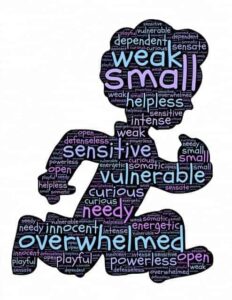Behavior change can be challenging.. possibly the understatement of the century. That’s exactly the kind of brilliant insight you’ve come to expect from me, no doubt! 😉
Okay seriously, how familiar does this sound…?
You embark on a new endeavor to make a positive change in your life: eat healthy food/avoid junk food, exercise regularly, read daily, meditate – whatever it is… might go something like this:
At the start: Here I come world, look out! Get that junk food outta here, I got my kale smoothie! Nothing can stop me this time, I’m on a mission! (level 6)
A few weeks in: Wow I’m tired of carrots and cucumbers. That cake sure looks good. Maybe just a bite. Man I hate dieting…. This sucks. (level 2 / 3)
A few weeks later: I can’t do this anymore. I’m tired of eating cardboard, I’m ordering a pizza. I don’t know why I even try, I always fail and end up right back here. (level 1)
Can you relate to something close to the above? I know I sure can. 
The driving factor behind each example is… you guessed it – emotion. Emotional energy provided the kick start needed to get going. It also allowed doubt to creep in and eventually the feeling of overwhelm took over.
Our emotions play a HUGE role in our behavior change efforts. This cannot be understated.
Understanding our energetic responses to situations in our lives is key to making sustainable change. All these energetic reactions can be categorized into levels (indicated in parenthesis above).
This post is intended to provide an overview of the energetic forces at work and describe the seven levels they can be categorized into.
Let’s jump in…
CATABOLIC VS ANABOLIC ENERGY
To start, let’s take a broader look at the forces in play: catabolic and anabolic energy.
Energy influences everything in our lives – including how we act and react – because it forms the “lens” through which we perceive the world.
For example, what if you believe that life is conspiring against your efforts to change eating habits? Perhaps something like this:
I mean come on, it’s summer – the time of BBQs, campouts, vacations – how am I supposed to eat healthy during summer?
Then comes fall and we have Halloween, followed immediately by Thanksgiving, then Christmas, then New Years parties. Holy hell.
Wait, then comes Valentines Day, then Easter, then Memorial Day… OMG now it’s summer again!
AHHH! HOW AM I EVER SUPPOSED TO LOSE WEIGHT???!!!
Ever feel something like that? Another example is that grumpy jerk we’ve all met. You know, that person who is just always in a sour mood and seems to want everyone else to feel as lousy as they do?
These are both examples of catabolic energy at work in our lives. This energy of worry, frustration and blame is ultimately destructive and, if left unchecked, can create a depressing, toxic environment.
On the other hand, what if you approach the world with the belief that life is full of opportunities – opportunities to grow, to challenge yourself, to share gratitude with and be in service of others? With a mindset like that, you will WELCOME all life has to offer!
Summer, holidays, gatherings, those are all just opportunities to enjoy life with friends, family and good food. No need to get off the “diet wagon” because you don’t live by such rules. You keep life in balance, on your terms.
That’s anabolic energy.
Anabolic energy is constructive and fuels creativity. Someone operating in the anabolic range has the ability to motivate and inspire others, influence positive outcomes and create incredible change within every area of their life – INCLUDING HEALTH AND FITNESS.
Now it might be easy to read the above descriptions and conclude that catabolic energy is bad and anabolic energy is good. To some degree, you would be correct. However, like most things in life, both types of energy have their own benefits and drawbacks.
Over the course of several blog posts (like this one, or this one, or that one), we’ll be exploring all of this in more detail.
For now, let’s take a quick overview of both energy sources in action. They can be categorized into seven levels.
ENERGY LEVELS AT A GLANCE
There are seven different primary “levels” to describe the types of energy a person experiences and expresses. Here’s how someone might react, at each level, in situations where they are trying to change their eating habits:
Level 1 (catabolic): Lack of choice. Victim energy. I can’t. I have to. Fearful.
“I can’t lose weight. I’ve tried and always fail. Plus, I just can’t seem to resist the tempting food that’s around me all the time. Why even try?”
Level 2 (catabolic): Anger. Combativeness. Resisting or fighting energy.
“If Joe brings donuts for us at work one more time, I might punch him in the face!”
Level 3 (becoming anabolic): Rationalizing. Fine.
“I eat okay. I mean, it’s not perfect, but it’s not like I’m eating pizza every night or anything. Could be a lot worse, that’s for sure.”
Level 4 (anabolic): Care. Compassion. Service to others.
“I feel my best when feeding my family healthy food. Sometimes I’ll eat the unhealthy food in the house, just so that the healthier options are available for them.”
Level 5 (anabolic): Reconciliation. Win-win. There’s no good or bad or right or wrong.
“We are hosting a get together this weekend and I’m making sure that there is a variety of foods for everyone. Food that I feel confident eating AND that I know they will enjoy as well.”
Level 6 (anabolic): Synthesis. Wisdom. Joy.
“Everyone, everything has a purpose. Joe bringing donuts is just Joe trying to be nice and share an experience. I love that about him and appreciate his kindness.”
Level 7 (anabolic): Complete passion for all aspects of life. Oneness.
“I feel complete passion and joy in this, and all situations. I create my reality.”

While you might notice that level 1 and 2 are largely catabolic and probably won’t bring about the greatest results, there’s no “good” or “bad” energy per se.
Each type of energy has inherent advantages and disadvantages and can be consciously used to reach specific goals. It’s also normal for us to cycle up and down the spectrum… we rarely hang out at one level all the time.
Over the several future blog posts, we’ll be exploring each energy level in more detail. Stay tuned…
READY TO EXPLORE HOW THESE ENERGY LEVELS SHOW UP IN YOUR LIFE?
Take the ELI assessment!
The ELI Assessment can be purchased by itself or as part of a coaching package.
As a certified ELI Master Practitioner, I will help to guide you in understanding your unique energy profile and give you first steps to create your new reality.
The assessment only takes about 20 minutes to complete. Once the results are in, I will guide you through a 1:1 Energy Leadership Index debrief session.
Through this personalized session, you’ll discover the percentage of each of the 7 energy levels that you typically experience under stress and also under “normal” conditions.
You’ll gain insights into where (and how) you’re investing your energy and discover a clear path to your goals—and likely, a higher A.R.L. From the assessment and debrief, you’ll be able to make a plan and adjust your priorities in support of your work and life goals.
The Energy Leadership™ Index (ELI) assessment is the proprietary, research-backed assessment tool that takes something abstract, like the way a person views the world, and turns it into something tangible—a metric that you can see and feel and even reevaluate in the future. And, it’s only available through a Certified ELI Master Practitioner, like me (Jeff Spitzer)!
Ready to take control? You can do it. I can help. Together we’ll crush it.
Jeff Spitzer
Web copy used by permission. No reproduction or retransmission is permitted without expressed written consent of Bruce D Schneider and the Institute for Professional Excellence in Coaching (iPEC).
© 2006 – 2011 Institute for Professional Excellence in Coaching (iPEC)
Visit the Energy Leadership main website at https://www.energyleadership.com/assessment.